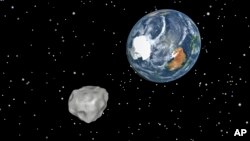Astronomers hope to learn more about Asteroid 2012 DA14's features and composition as it flies past Earth at about 7.8 kilometers per second - far faster than a speeding bullet. But that's not all they hope to discern when the object comes within 28,000 kilometers of our planet on February 15.
Spin
Michael Busch is a planetary astronomer at the National Radio Astronomy Observatory in the southwestern U.S. state of New Mexico. He says the direction of DA14's spin is important in predicting the way its orbit will change over time.
"One of the interesting things about DA14 is we expect its spin state will change as it flies by the Earth," said Busch. "The Earth's gravity will pull slightly more on one side of the asteroid than on the other, and that will change its spin."
Speckles
The U.S. space agency's Goldstone antenna in the western state of California will beam radio waves toward the asteroid. Busch and his team will be about 1,000 kilometers away in New Mexico, where the National Radio Astronomy Observatory operates a pair of antennas, about 400 kilometers apart. The two antennas will receive the waves reflected off the asteroid's uneven surface.
Busch explains parts of the asteroid will reflect the signal differently, allowing astronomers to observe so-called "speckles."
"That pattern is random, but it moves across the Earth as the asteroid spins, so by tracking the time difference in when a different speckle arrives at a given antenna, I can figure out how fast and in what direction the asteroid is spinning," he said.
Changes in Orbit
Busch also explains that the part of the asteroid that is in view of the sun develops a hot spot that radiates heat. This exerts a gentle, jet-like push that can speed up or slow down the asteroid. Over time, this can significantly alter its orbit.
Astronomers with NASA, the U.S. space agency, say 2012 DA14's next notable close approach to our planet will be in 2046, and even then, it won't strike the Earth.
Busch notes that while scientists can - for the most part - precisely predict DA14's orbit for the next century, this space rock will yield important insights into the behavior of other asteroids.
"With the radar observations that we'll get this weekend after the close approach and the optical infrared data that is also coming in, we will be able to much better predict where DA14 in particular is going and run that orbit out much further into the future," said Busch. "But this also lets us begin to understand the properties of the near-Earth asteroids as a population."
The U.S. space agency says, on average, an asteroid the size of 2012 DA14 gets close every 40 years and hits every 1,200 years.
Spin
Michael Busch is a planetary astronomer at the National Radio Astronomy Observatory in the southwestern U.S. state of New Mexico. He says the direction of DA14's spin is important in predicting the way its orbit will change over time.
"One of the interesting things about DA14 is we expect its spin state will change as it flies by the Earth," said Busch. "The Earth's gravity will pull slightly more on one side of the asteroid than on the other, and that will change its spin."
Speckles
The U.S. space agency's Goldstone antenna in the western state of California will beam radio waves toward the asteroid. Busch and his team will be about 1,000 kilometers away in New Mexico, where the National Radio Astronomy Observatory operates a pair of antennas, about 400 kilometers apart. The two antennas will receive the waves reflected off the asteroid's uneven surface.
Busch explains parts of the asteroid will reflect the signal differently, allowing astronomers to observe so-called "speckles."
"That pattern is random, but it moves across the Earth as the asteroid spins, so by tracking the time difference in when a different speckle arrives at a given antenna, I can figure out how fast and in what direction the asteroid is spinning," he said.
Changes in Orbit
Busch also explains that the part of the asteroid that is in view of the sun develops a hot spot that radiates heat. This exerts a gentle, jet-like push that can speed up or slow down the asteroid. Over time, this can significantly alter its orbit.
Astronomers with NASA, the U.S. space agency, say 2012 DA14's next notable close approach to our planet will be in 2046, and even then, it won't strike the Earth.
Busch notes that while scientists can - for the most part - precisely predict DA14's orbit for the next century, this space rock will yield important insights into the behavior of other asteroids.
"With the radar observations that we'll get this weekend after the close approach and the optical infrared data that is also coming in, we will be able to much better predict where DA14 in particular is going and run that orbit out much further into the future," said Busch. "But this also lets us begin to understand the properties of the near-Earth asteroids as a population."
The U.S. space agency says, on average, an asteroid the size of 2012 DA14 gets close every 40 years and hits every 1,200 years.







